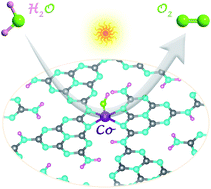Single-atom cobalt-hydroxyl modification of polymeric carbon nitride for highly enhanced photocatalytic water oxidation: ball milling increased single atom loading†
Abstract
Expediting the oxygen evolution reaction (OER) is the key to achieving efficient photocatalytic overall water splitting. Herein, single-atom Co–OH modified polymeric carbon nitride (Co-PCN) was synthesized with single-atom loading increased by ∼37 times with the assistance of ball milling that formed ultrathin nanosheets. The single-atom Co-N4OH structure was confirmed experimentally and theoretically and was verified to enhance optical absorption and charge separation and work as the active site for the OER. Co-PCN exhibits the highest OER rate of 37.3 μmol h−1 under visible light irradiation, ∼28-fold higher than that of common PCN/CoOx, with the highest apparent quantum yields reaching 4.69, 2.06, and 0.46% at 400, 420, and 500 nm, respectively, and is among the best OER photocatalysts reported so far. This work provides an effective way to synthesize efficient OER photocatalysts.



 Please wait while we load your content...
Please wait while we load your content...